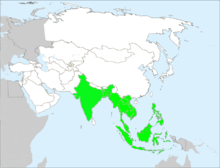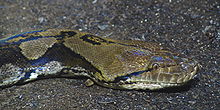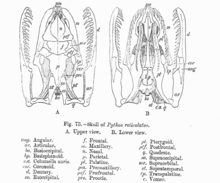Reticulated python
| Reticulated python | |
|---|---|

| |
| Scientific classification | |
| Kingdom: | |
| Phylum: | |
| Subphylum: | |
| Class: | |
| Order: | |
| Suborder: | |
| Family: | |
| Genus: | |
| Species: | P. reticulatus
|
| Binomial name | |
| Python reticulatus | |

| |
| Synonyms | |
| |
Python reticulatus, also known as the (Asiatic) reticulated python[4], is a species of python found in Southeast Asia. Adults can grow to 6.95 metres (22.8 ft) in length[5] but normally grow to an average of 3-6 meters (10–20 feet). They are the world's longest snakes and longest reptile, but are not the most heavily built. Like all pythons, they are nonvenomous constrictors and normally not considered dangerous to humans. Although large specimens are powerful enough to kill an adult human, attacks are only occasionally reported.
An excellent swimmer, Python reticulatus has been reported far out at sea and has colonized many small islands within its range. The specific name, reticulatus, is Latin meaning "net-like", or reticulated, and is a reference to the complex color pattern.[6]
Description

In general, reticulated pythons with lengths of more than 6 metres (20 ft) are rare. One of the largest scientifically measured specimens, which was from Balikpapan, East Kalimantan, Indonesia, was measured under anesthesia at 6.95 metres (22.8 ft) and weighed 59 kilograms (130 lb) after not having eaten for 3 months.[5] Widely published data of specimens that were reported to be several feet longer have not been confirmed.
Even what was widely accepted as the largest ever "accurately" measured snake, that being Colossus, a male kept at the Highland Park Zoo (now Pittsburgh Zoo & PPG Aquarium) in Pittsburgh, Pennsylvania during the 1950s and early 1960s, with a peak reported length of 8.7 metres (29 ft), recently turned out to be wrong. When Colossus died, April 14, 1963, its body was deposited in the Carnegie Museum of Natural History. At that time its skeleton was measured and found to be 20 ft 10 in (6.35 m) in total length, significantly shorter than the measurements previously published by Barton and Allen. Apparently, they had been adding a few extra feet to the measurements to compensate for "kinks", since it is virtually impossible to completely straighten an extremely large live python. Too large to be preserved with formaldehyde and then stored in alcohol, the specimen was instead prepared as a disarticulated skeleton. The hide was sent to a laboratory to be tanned, and unfortunately it was either lost or destroyed.[7]
Numerous reports have been made of larger snakes, but since none of these has been measured by a scientist nor have the specimens been deposited at a museum, they must be regarded as unproven and possibly erroneous. In spite of what was for many years a standing offer of $50,000 for a live, healthy snake over 9.1 metres (30 ft) long by the New York Zoological Society (NYZS), known since 1993 as the Wildlife Conservation Society (WCS), no attempt to claim this reward was ever made.[8]

The color pattern is a complex geometric pattern that incorporates different colors. The back typically has a series of irregular diamond shapes, flanked by smaller markings with light centers. In this species' wide geographic range, much variation of size, color, and markings commonly occurs.
In zoo exhibits the color pattern may seem garish, but in a shadowy jungle environment amid fallen leaves and debris it allows them to virtually disappear. Called a disruptive coloration, it protects them from predators and helps them to catch their prey.[9]
It is the longest snake in the Asia
Geographic range
Reticulated pythons are found in Southeast Asia from the Nicobar Islands, northeast India, Bangladesh, Burma, Thailand, Laos, Cambodia, Vietnam, Malaysia and Singapore, east through Indonesia and the Indo-Australian Archipelago (Sumatra, the Mentawai Islands, the Natuna Islands, Borneo, Sulawesi, Java, Lombok, Sumbawa, Sumba, Flores, Timor, Maluku, Tanimbar Islands) and the Philippines (Basilan, Bohol, Cebu, Leyte, Luzon, Mindanao, Mindoro, Negros, Palawan, Panay, Polillo, Samar, Tawi-Tawi). The original description does not include a type locality. Restricted to "Java" by Brongersma (1972).[2]
Three subspecies have been proposed,[10] but are not recognized in the Integrated Taxonomic Information System (ITIS). The color and size can vary a great deal among the subspecies described. Geographical location is a good key to establishing the subspecies, as each one has a distinct geographical range.
Habitat
The reticulated python lives in rain forests, woodlands, and nearby grasslands. It is also associated with rivers and is found in areas with nearby streams and lakes. An excellent swimmer, it has even been reported far out at sea and has consequently colonized many small islands within its range.[9] During the early years of the twentieth century it is said to have been common even in busy parts of Bangkok, sometimes eating domestic animals.[11]
Feeding
Their natural diet includes mammals and occasionally birds. Small specimens up to 3-4 meters (10–14 ft) long eat mainly rodents such as rats, whereas larger individuals switch to prey such as Viverridae (e.g. civets and binturongs), and even primates and pigs. Near human habitation, they are known to snatch stray chickens, cats and dogs on occasion. Among the largest, fully documented prey items to have been taken are a half-starved Sun Bear of 23 kilograms that was eaten by a 6.95 m (23 ft) specimen and took some ten weeks to digest, as well as pigs of more than 60 kg (132 lb).[12] As a rule of thumb, these snakes seem able to swallow prey up to ¼ their own length, and up to their own weight.[13] As with all pythons, they are primarily ambush hunters, usually waiting until prey wanders within strike range before seizing it in their coils and killing via constriction. However, there is at least one documented case of a foraging python entering a forest hut and taking a child.[14]
Danger to humans
Attacks on humans are rare, but this species has been responsible for several human fatalities, in both the wild and captivity. They are among the few snakes that have been fairly reliably reported to eat people, although only a few cases of the snake actually eating (rather than just killing) a human appear to be authenticated:
- Two incidents, apparently in early 20th century Indonesia: On Salibabu, a 14-year-old boy was killed and supposedly eaten by a specimen 5.17 m (c.17 ft) in length. Another incident involved an adult woman reputedly eaten by a "large reticulated python", but few details are known.[15]
- Franz Werner reported a case from Burma occurring either in the early 1910s or in 1927.[8] A jeweller named Maung Chit Chine, who went hunting with his friends, was apparently eaten by a 6 m (20 ft.) specimen after he sought shelter from a rainstorm in or under a tree. Supposedly, he was swallowed feet-first, contrary to normal snake behavior, but perhaps the easiest way for a snake to actually swallow a human.[16]
- In 1932, Frank Buck wrote about a teenage boy who was eaten by a pet 25 ft (7.6 m). reticulated python in the Philippines. According to Buck, the python escaped, and when it was found, a human child's shape was recognized inside the snake. It turned out to be the son of the snake's owner.[8]
- Among a small group of Agta negritos in the Philipppines, six deaths by python have been documented within a period of 40 years, plus one who died later of an infected bite.[17]
- On September 4, 1995, Ee Heng Chuan, a 29-year-old rubber tapper from the southern Malaysian state of Johor, was killed by a large reticulated python. The victim had apparently been caught unaware and was squeezed to death. The snake had coiled around the lifeless body with the victim's head gripped in its jaws when it was stumbled upon by the victim's brother. The python, measuring 23 ft (7.0 m) long and weighing more than 300 lb, was killed soon after by the arriving police, who required four shots to bring it down.[8]
- According to Mark Auliya, the corpse of 32-year-old Mangyan, Lantod Gumiliu, was recovered from the belly of a 7-metre (23 ft) reticulated python on Mindoro, probably in January, 1998.[13]
- On October 23, 2008, a 25-year-old Virginia Beach, Virginia woman, Amanda Ruth Black, appeared to have been killed by a 13-foot (4.0 m) pet reticulated python. The apparent cause of death was asphyxiation. The snake was later found in the bedroom in an agitated state.[18]
- On January 21, 2009, a 3-year-old Las Vegas boy was wrapped by an 18-foot (5.5 m) pet reticulated python, turning blue. The boy's mother, who had been babysitting the python on behalf of a friend, rescued the toddler by gashing the python with a knife. The snake was later euthanized because of its fatal wounds.[19]
Considering the known maximum prey size, it is technically possible for a full-grown specimen to open its jaws wide enough to swallow a human child, teenager, or even an adult, although the flaring shoulders of Homo sapiens could pose a problem for a snake with insufficient size (< 6 meters). The victim would almost certainly be dead by the time the snake started swallowing.
Reproduction
Oviparous, females lay between 15 and 80 eggs per clutch. At an optimum incubation temperature of 31–32°C (88–90 °F), the eggs take an average of 88 days to hatch.[20] Hatchlings are at least 2 feet (61 cm) in length.[11]
Captivity
Increased popularity in the pet trade is due largely to increased efforts in captive breeding and selectively bred mutations such as the "albino" and "tiger" strains. They can make good captives, but keepers should have previous experience with such large constrictors to ensure safety to both animal and keeper. Although their interactivity and beauty draws much attention, some feel they are unpredictable.[21][22] They do not attack humans by nature, but will bite and possibly constrict if they feel threatened, or mistake a hand for food. While not venomous, large pythons can inflict serious injuries, sometimes requiring stitches.
The huge size and attractive pattern of these snakes has made them favorite zoo exhibits, with several individuals claimed to be above 20 feet (6.1 m) in length and more than one claimed to be the largest in captivity.[23][24][25][26] However, due to their huge size, immense strength, aggressive disposition, and the mobility of the skin relative to the body, it is very difficult to get exact length measurements on a living reticulated python, and weights are rarely indicative, as captive pythons are often obese.[8] Claims made by zoos and animal parks are sometimes exaggerated, such as the claimed 49-foot (15 m) snake in Indonesia which was subsequently proven to be less than 23 feet (7.0 m) long.[27] For this reason, scientists do not accept the validity of length measurements unless performed on a dead or anaesthetized snake which is later preserved in a museum collection.[8] There are now "super dwarf" reticulated pythons from some islands north west of Australia where the adults rarely get more than 15 feet (4.6 m) long, and are being bred to be much smaller. Males can be at most 5 feet (1.5 m) long, females a little longer.
Taxonomy
Three subspecies may be encountered, including two new ones:
- P. r. reticulatus, Schneider (1801) - Called "retics" in herpetoculture.
- P. r. jampeanus, Auliya et al. (2002) - Kayaudi dwarf reticulated pythons or Jampea retics, about half the length,[20] or according to Auliya et al. (2002), not reaching much more than 2 m in length.[10] Found on Tanahjampea in the Selayar Archipelago south of Sulawesi. Closely related to P. r. reticulatus of the Lesser Sundas.[10]
- P. r. saputrai, Auliya et al. (2002) - Selayer reticulated pythons or Selayer retics. Found on Selayar Island in the Selayar Archipelago and also adjacent Sulawesi. This subspecies represents a sister lineage to all other populations of reticulated pythons tested.[10] According to Auliya et al. (2002) it does not exceed 4 m in length.[10]
The latter two are dwarf subspecies. Apparently, the population of the Sangihe Islands north of Sulawesi represents another such subspecies which is basal to the P. r. reticulatus plus P. r. jampeanus clade, but it is not yet formally described.[10]
The proposed subspecies dalegibbonsi, euanedwardsi, haydnmacphiei, neilsonnemani, patrickcouperi and stuartbigmorei[28][29] have not found general acceptance.
A recent phylogenetic study of pythons [30] suggested that the reticulated python as well as the Timor python are more closely related to Australasian pythons than other members of the genus Python, and should therefore be placed in a separate genus, Broghammerus.
See also
References
- ^ ITIS (Integrated Taxonomic Information System). www.itis.gov.
- ^ a b McDiarmid RW, Campbell JA, Touré T. 1999. Snake Species of the World: A Taxonomic and Geographic Reference, vol. 1. Herpetologists' League. 511 pp. ISBN 1-893777-00-6 (series). ISBN 1-893777-01-4 (volume).
- ^ The reptile Database. www.reptile-database.org.
- ^ "Python reticulatus". Integrated Taxonomic Information System. Retrieved 12 September 2007.
- ^ a b G. M. Fredriksson: Predation on Sun Bears by Reticulated Python in East Kalimantan, Indonesian Borneo. Raffles Bulletin of Zoology 53(1), 2005, p. 165-168, pdf.
- ^ Gotch AF. 1986. Reptiles -- Their Latin Names Explained. Poole, UK: Blandford Press. 176 pp. ISBN 0-7137-1704-1.
- ^ Barker, David G.; Stephen L. Barten, DVM; Jonas P. Ehrsam; and Louis Daddono. 2012. The Corrected Lengths of Two Well-known Giant Pythons and the Establishment of a new Maximum Length Record for Burmese Pythons, Python bivittatus. Bull. Chicago Herp. Soc. 47(1):1-6, pdf.
- ^ a b c d e f Murphy JC, Henderson RW. 1997. Tales of Giant Snakes: A Historical Natural History of Anacondas and Pythons. Krieger Pub. Co. 221 pp. ISBN 0-89464-995-7. Cite error: The named reference "Mur97" was defined multiple times with different content (see the help page).
- ^ a b Mehrtens JM. 1987. Living Snakes of the World in Color. New York: Sterling Publishers. 480 pp. ISBN 0-8069-6460-X.
- ^ a b c d e f Auliya, M. (2002-04-09). "Review of the reticulated python (Python reticulatus Schneider, 1801) with the description of new subspecies from Indonesia". Naturwissenschaften. 89 (5): 201–213. doi:10.1007/s00114-002-0320-4. Retrieved 2012-04-08.
{{cite journal}}: Unknown parameter|coauthors=ignored (|author=suggested) (help) - ^ a b Stidworthy J. 1974. Snakes of the World. Grosset & Dunlap Inc. 160 pp. ISBN 0-448-11856-4.
- ^ Shine R, Harlow PS, Keogh JS, Boeadi NI. (1998). The influence of sex and body size on food habits of a giant tropical snake, Python reticulatus. Functional Ecology 12:248–258.
- ^ a b Fredriksson, Gabriella M. (2005): Predation on Sun Bears by Reticulated Python in East Kalimantan, Indonesian Borneo. Raffles Bulletin of Zoology 53(1): 165-168. PDF fulltext
- ^ Thomas N. Headland and Harry W. Greene. 2011. Hunter–gatherers and other primates as prey, predators, and competitors of snakes. Proceedings of the National Academy of Sciences 108.52.
- ^ Kopstein, F. (1927): Over het verslinden van menschen door Python reticulatus ["On the swallowing of humans by P. reticulatus"]. Tropische Natuur 4: 65–67. [Article in Dutch][verification needed]
- ^ Bruno, Silvio (1998): I serpenti giganti ["The giant snakes"]. Criptozoologia 4: 16–29. [Article in Italian] HTML fulltext
- ^ Thomas N. Headland and Harry W. Greene. 2011. Hunter–gatherers and other primates as prey, predators, and competitors of snakes. Proceedings of the National Academy of Sciences 108.52.
- ^ Woman killed by pet 13-foot python at UPI. Accessed 27 October 2008.
- ^ In Las Vegas, python vs. angry mom with a knife at Las Vegas Sun. Accessed 23 January 2009.
- ^ a b Mattison, Christopher (1999): Snake. DK Publishing. ISBN 0-7894-4660-X.
- ^ "Reticulated Python Care (Python reticulatus) - Eco Terrarium Supply". Retrieved 2009-02-06.
- ^ "Reticulated Pythons - Boatips.com". Retrieved 2009-02-06.
- ^ "Columbus Zoo Pays to Keep Largest Snake in Captivity on Permanent Display". Fox News. 14 January 2008.
- ^ Orlando News: 22-Foot Python In Fla. Is World's Largest
- ^ Rimba Reptil ( Rimba Reptile Park )
- ^ New York Time: Never Leather, Samantha The Python Dies at the Zoo (November 22, 2002)
- ^ Stay still, will you?
- ^ Hoser, Raymond (2003): A Reclassification of the Pythoninae Including the Descriptions of Two New Genera, Two New Species, and Nine New Subspecies. Part I. Crocodilian 4(3): 31-37. HTML fulltext
- ^ Hoser, Raymond (2004): A Reclassification of the Pythoninae Including the Descriptions of Two New Genera, Two New Species, and Nine New Subspecies. Part II. Crocodilian 4(4): 21-40. HTML fulltext
- ^ Rawlings, L.H., Rabosky, D.L., Donnellan, S.C. & Hutchinson, M.N. (2008) Python phylogenetics: inference from morphology and mitochondrial DNA. Biological Journal of the Linnean Society 93: 603-629.
Further reading
- Auliya, M.A. (2003): Taxonomy, Life History and Conservation of Giant Reptiles in West Kalimantan. Ph.D. thesis, University of Bonn.
- Auliya, M.A.; Mausfeld, P.; Schmitz, A. & Böhme, W. (2002): Review of the reticulated python (Python reticulatus Schneider, 1801[sic]) with the description of new subspecies from Indonesia. Naturwissenschaften 89(5): 201-213. doi:10.1007/s00114-002-0320-4 (HTML abstract, electronic supplement available to subscribers)
- Raven, H.C. (1946): Adventures in python country. Natural History 55: 38-41.
- Shine R, Ambariyanto, Harlow PS, Mumpuni. Reticulated pythons in Sumatra: biology, harvesting and sustainability. Biol. conserv. ISSN 0006-3207. Abstract at CAT.INIST. Accessed 12 September 2007.
External links
- Reticulated python life history at Reticulatedpython.info . Accessed 7 November 2009
- Python reticulatus at ReptileExpert.org. Accessed 22 August 2011.
- Reticulated python at Answers.com. Accessed 12 September 2007.
- Study of man-eating snakes: Snakes are predators on, prey of, and competitors with primates Cornell Chronicle Online. Accessed 22 December 2011.
